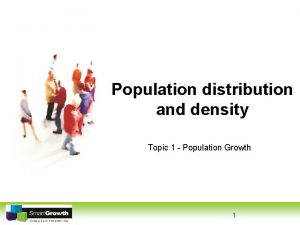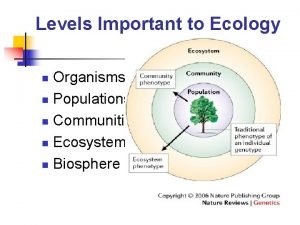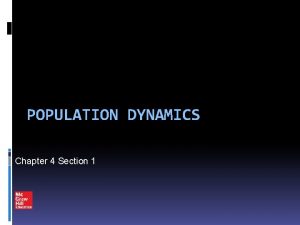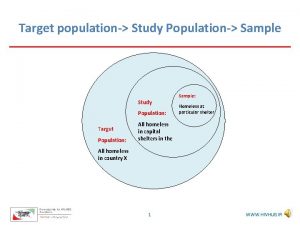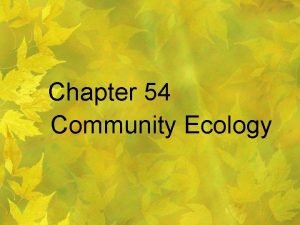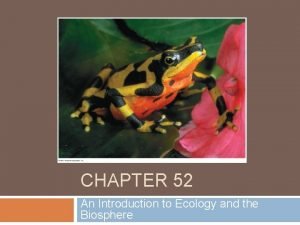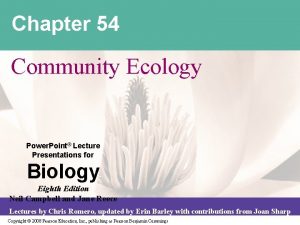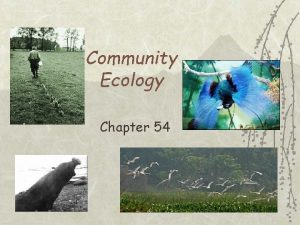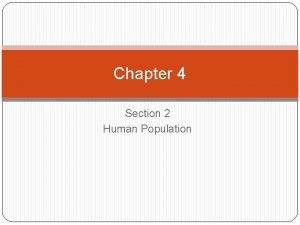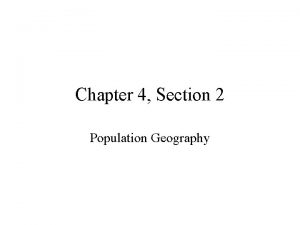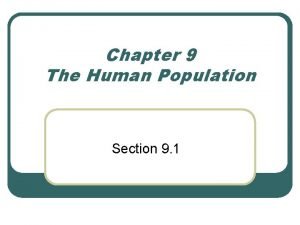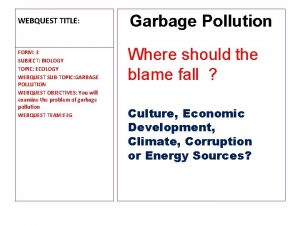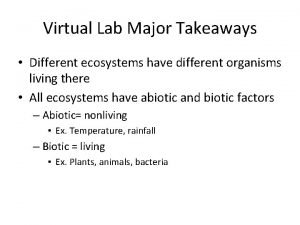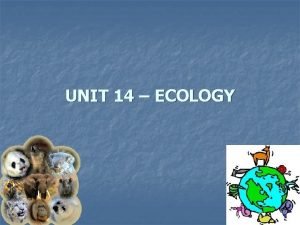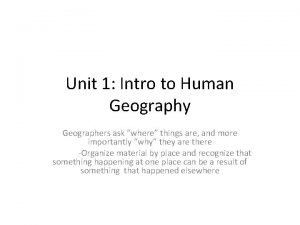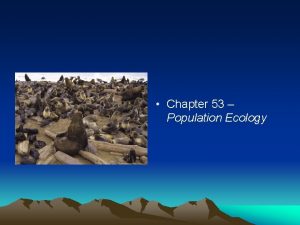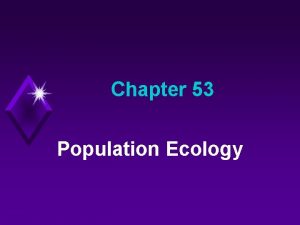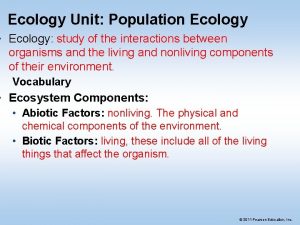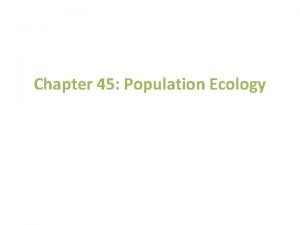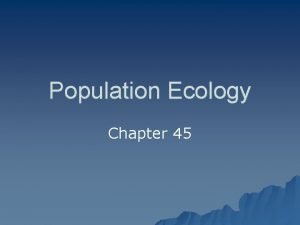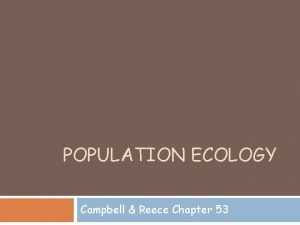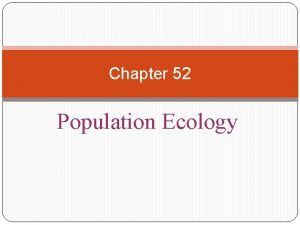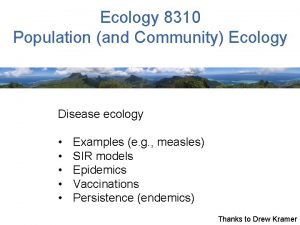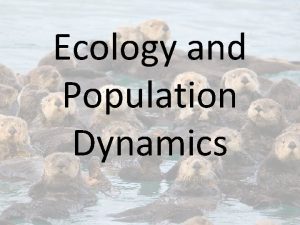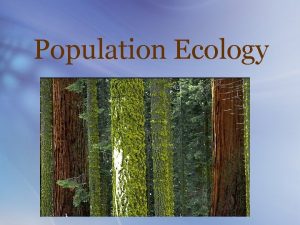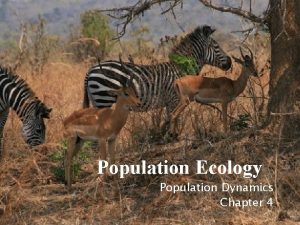Chapter 53 Population Ecology Population Ecology Study of


























































- Slides: 58

Chapter 53 Population Ecology

Population Ecology • Study of the factors that affect population size and composition.

Population • Individuals of a single species that occupy the same area.

Population Dynamics

Important Characteristics 1. Density 2. Dispersion

Density • Number of individuals per unit area or volume. • Ex: – Diatoms - 5 million/m 3 – Trees - 5, 000/km 2 – Deer - 4/km 2

Dispersion • Pattern of spacing among individuals. • Types: 1. Clumped 2. Uniform 3. Random


Clumped Dispersion • May result form a patchy environment. • May increase chances for survival. • Ex: – Schooling behavior – Flocks of birds

Uniform Dispersion • Often the result of antagonistic interactions between individuals. • Ex: – Territories – Spacing between desert plants

Random Dispersion • Often the result of the absence of strong attractions or repulsions between individuals. • Not a common pattern.

Demography • The study of the vital statistics that affect population size. • Ex: Birth and Death rates

Demographic Factors • Age structure of the population. • Birth and Death rates. • Generation time. • Sex ratio and reproductive behavior.

Life Tables • Mortality summary for a cohort of individuals. • First developed from life insurance studies.


Life Tables Show • Mortality rate per year. • Life span of the organism. • Fecundity (birth rate).

Survivorship Curve • Plot of the numbers of a cohort still alive over time. • Curve Types: – Type III


Type I • Low early deaths. • High late deaths. • Ex: – Humans – Other large mammals

Type II • Constant death rate. • Ex: – Annual plants – Many invertebrates

Type III • High early deaths. • Low late deaths. • Ex: – Trees – Oysters

Comment • Curve type may change between young and adults. • Ex: Nestlings - Type III Adult Birds- Type II

Life History Strategies • Are the product of natural selection. • Can favor – Maximize survival – Maximize reproduction

Examples • Semelparity – one shot reproduction with many offspring. – Ex. – Salmon, Agave • Iteroparity – repeated reproduction events with a few offspring each time.

Life History Strategies 1. "r" or Opportunistic species 2. "k" or Equilibrial species

"r" Species • Increase fitness by producing as many offspring as possible. • Do this by: – Early maturation – Many reproductive events – Many offspring

Result • Maximize reproduction so that at least a few offspring survive to the next generation. • Most offspring die (Type III curve).

"k" Species • Increase fitness by having most offspring survive. • Do this by: – – High parental care Late maturation Few reproduction events Few offspring.

Result • Maximize survivorship of each offspring. • Few offspring, but most survive (Type I curve).

What is the strategy • For a weed? • For an endangered species? • For Garden Pests?

Population Growth DN/Dt = b - d • Where: – – N= population size t = time b = birth rate d = death rate

Rate of Increase • r = difference between birth rate and death rate. • r=b-d

Assignments • • Read Chapter 53 or 43 in Hillis Chapter 52 – today Chapter 53 – Mon. 4/28 Labs – Transpiration, Aquatic Productivity

Equation: DN/Dt = r. N • N = population size • t = time • r = rate of increase

From Calculus • The equation DN/Dt = r. N becomes: • d. N/dt = rmax N • rmax = intrinsic rate of increase

Exponential Growth • d. N/dt = rmax N • Characteristic of "r" species. • Produces a “J-shaped” growth curve. • Only holds for ideal conditions and unlimited resources.


Logistic Growth • d. N/dt = rmax N K-N K • K = carrying capacity

Result • “S-shaped” growth curve. • Characteristic of “k" species. • Common when resources are limited.


Comment • K is not a constant value. • Populations often oscillate around “K” as the environment changes.


Additional Comments • Populations often overshoot “K”, then drop back to or below “K”. • The equations are now on the AP formula sheet. Be prepared to use them.

Regulation of Population Size 1. Density- Dependent Factors 2. Density- Independent Factors

Density-Dependent • Affect is related to N. • As N increases, mortality increases. • Ex: Food, nesting space, disease


Density-Independent • Affect is not related to N. • Mortality not related to population size. • Ex: Weather and climate

Population Cycles • Cyclic changes in N over time. • Often seen in predator/prey cycles. • Ex: Snowshoe Hare - Lynx


Causes • Density dependent factors. • Chemical cycles. • Saturation strategy to confuse predators.

Age Structure Diagrams • Show the percent of a population in different age categories. • Method to get data similar to a Life Table, but at one point in time.


Importances • Can be used to predict future population growth trends, especially for long lived species.

Exponential Growth • Produces age structures that are a triangle or pyramid shape.

Logistic Growth • Produces age structures that have even sizes between most age categories.

Declining Populations • Produce age structures with a narrow base and wider middles.

Summary • Know density and dispersion patterns. • Know Life Tables and survivorship curves. • Be able to contrast and compare “r” and “k” strategies.

Summary • Know exponential and logistic growth curves and equations. • Know density and densityindependent growth factors.
 Chapter 4 population ecology worksheet answer key
Chapter 4 population ecology worksheet answer key Section 1 population dynamics answer key
Section 1 population dynamics answer key Population ecology section 1 population dynamics
Population ecology section 1 population dynamics Population ecology section 1 population dynamics
Population ecology section 1 population dynamics Chapter 53 population ecology
Chapter 53 population ecology Equilibrial life history
Equilibrial life history Chapter 4 population ecology answer key
Chapter 4 population ecology answer key Chapter 53 population ecology
Chapter 53 population ecology Chapter 4 section 1 population dynamics answer key
Chapter 4 section 1 population dynamics answer key Chapter 53 population ecology
Chapter 53 population ecology Chapter 3 section 1: community ecology answer key
Chapter 3 section 1: community ecology answer key Clumped dispersion
Clumped dispersion Define exponential population growth
Define exponential population growth Organismal ecology
Organismal ecology Population vs community ecology
Population vs community ecology Concept 3 population ecology
Concept 3 population ecology Lynx and hare relationship
Lynx and hare relationship Population characteristics ecology
Population characteristics ecology Population characteristics ecology
Population characteristics ecology What is population ecology
What is population ecology Population definition ecology
Population definition ecology Population distribution
Population distribution Parasitism
Parasitism Whats a density independent factor
Whats a density independent factor Ecology study guide answers
Ecology study guide answers Ecology is the study that helps to preserve
Ecology is the study that helps to preserve What is a study population
What is a study population Study population
Study population Chapter 52: an introduction to ecology and the biosphere
Chapter 52: an introduction to ecology and the biosphere Chapter 56 conservation biology and restoration ecology
Chapter 56 conservation biology and restoration ecology Phosphorus cycle pearson education
Phosphorus cycle pearson education Chapter 54 community ecology
Chapter 54 community ecology Chapter 52 an introduction to ecology and the biosphere
Chapter 52 an introduction to ecology and the biosphere Chapter 5 evolution and community ecology answer key
Chapter 5 evolution and community ecology answer key Principles of ecology section 2 flow of energy
Principles of ecology section 2 flow of energy Chapter 2 principles of ecology answer key
Chapter 2 principles of ecology answer key Principles of ecology chapter 2 section 1 answer key
Principles of ecology chapter 2 section 1 answer key Chapter 54 community ecology
Chapter 54 community ecology Chapter 55 ecosystems and restoration ecology
Chapter 55 ecosystems and restoration ecology Chapter 5 evolution and community ecology
Chapter 5 evolution and community ecology Chapter 5 evolution and community ecology answer key
Chapter 5 evolution and community ecology answer key Principles of ecology chapter 2 section 1 answer key
Principles of ecology chapter 2 section 1 answer key Chapter 54 community ecology
Chapter 54 community ecology What is case series
What is case series Retrospective cohort study vs prospective cohort study
Retrospective cohort study vs prospective cohort study Process of method study
Process of method study Marty lobdell study less study smart
Marty lobdell study less study smart Study to study
Study to study Differentiate between time study and motion study
Differentiate between time study and motion study Difference between time study and motion study
Difference between time study and motion study Chapter 4 section 2 human population
Chapter 4 section 2 human population Chapter 4 section 2 population geography
Chapter 4 section 2 population geography Key issue 3 why do some places face health challenges
Key issue 3 why do some places face health challenges Chapter 9 the human population section 1
Chapter 9 the human population section 1 Ecology webquest answers
Ecology webquest answers Food chain virtual lab
Food chain virtual lab Unit 7 ecology answer key
Unit 7 ecology answer key Biotic community is another name for____
Biotic community is another name for____ Perceptual region definition
Perceptual region definition





















